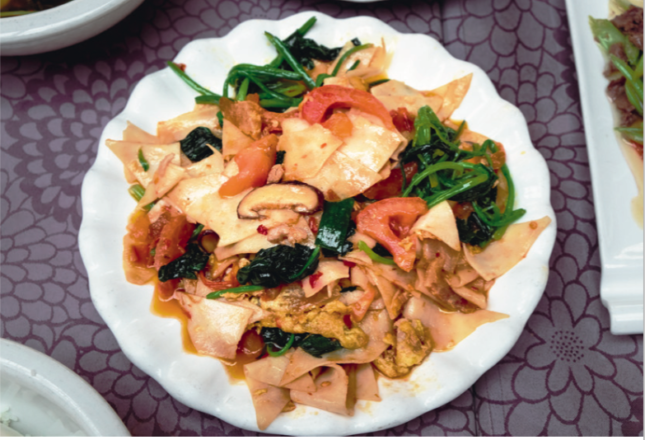From the Book: Da Jiu Jia—Stir-Fried Rice Cakes with Pork Belly, Tomatoes, and Spinach
March 15th, 2020

This is one of the recipes we make over and over again. It’s one of those rare Chinese dishes that can really be a meal all on its own*; it’s got starch, protein, and vegetables all on one plate. And it’s absolutely, amazingly delicious.
As I wrote in the book:
“Dishes made with er kuai rice cakes are popular throughout Yunnan, but this is the most famous preparation. It comes from the city of Tengchong, a busy trading center on Yunnan’s border with Myanmar, and dates from the end of the Southern Ming Dynasty in the 1660s. According to local lore, the Yongli Emperor, Zhu Youlang, took refuge in the city in 1661, having fled from the Manchus (the founders of the Ming Dynasty). He arrived in Tengchong tired and starving and called for food, and a cook rushed to prepare something for the emperor to eat. At the time, locals prepared er kuai by cutting it into thin, noodle-like strips and boiling them in soup, but with no time to waste, the cook decided to stir-fry thin slices of the rice cake instead. The emperor ate the dish gratefully, then asked the cook what it was called. When he learned that the recipe had no name, he decreed it would be called dajiujia, or “saving the life of the emperor.” Unfortunately for Zhu Youlang, the dish couldn’t save him from his ultimate fate—he was captured and executed by the Manchus a few months later. But the dish he named lived on and is now served in restaurants across Yunnan.
This is the rare stir-fry that is perfect to eat on its own—a combination of meat, egg, and vegetables all on one plate. This version comes from Beside the Lotus Kitchen Secrets, a large restaurant built in the countryside a few minutes outside of Heshun, where it is served with a mild soup on the side to help diners digest the meat and starch. Other versions of the dish substitute sweet pea greens or sliced cabbage for the spinach, use different cuts of pork, or swap garlic chives for the scallions. All are utterly delicious.”
Stir-Fried Rice Cakes with Pork Belly, Tomatoes, and Spinach
6 oz. pork belly with the skin removed
1 egg
3 tbsp. vegetable oil
1/3 cup thinly sliced brown button mushrooms
3/4 lb. Yunnan Rice Cakes (er kuai), cut into triangular slices 1/8 inch thick (2 1/2 cups), or the same amount of sliced Korean rice cakes, sometimes labeled “ovalettes”
1 1/2 cups spinach leaves, cut in half crosswise (3 oz.)
1 large, firm tomato, or 2 Roma (plum) tomatoes, cut into slices 1/4 inch thick
5 scallions, white and light green parts only, cut into 1/2-inch pieces
1 tbsp. light soy sauce
1/4 tsp. salt
Cut the pork belly into strips 1/8 inch thick (cutting through the layers of meat and fat so that each piece is striated, like bacon), then cut the strips into 1-inch-long pieces (you will have about 3/4 cup). Lightly beat the egg and mix it with the pork belly.
In a wok, heat the oil over a high flame until very hot. Add the meat and egg mixture, let the egg puff up, without stirring, for 30 seconds, then flip it and break up the egg, separating the pieces of meat from one another. Add the mushrooms and cook for 1 minute, pressing them up against the sides of the wok for a few seconds at a time to brown. Add the rice cakes, spinach, and tomato and stir-fry, stirring and flipping constantly, for 1 minute. Add the scallions and stir-fry for 1 more minute. Add the soy sauce and salt and stir-fry until the rice cake slices are tender, about 3 to 4 minutes.
*Technically, if you’re in Yunnan, you always have this dish with a soup to accompany it, to help digestion. But from an American perspective, it’s great on its own.
Photo: Josh Wand (From Cooking South of the Clouds—Recipes and Stories from China’s Yunnan Province)



